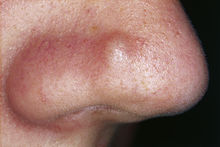Fibrous papule of the nose
| Fibrous papule of the nose | |
|---|---|
| Other names | Benign solitary fibrous papule, fibrous papule of the face[1] |
 | |
| Fibrous papule of the nose | |
| Specialty | Dermatology |
| Symptoms | Persistent, usually solitary, unchanging, small, shiny, smooth, firm bump on or near nose[1] |
| Usual onset | Young adult[2] |
| Duration | Permanent[2] |
| Causes | Unknown,[3] originates in dermal dendrocyte[4] |
| Diagnostic method | Appearance, skin biopsy, histopathology[3] |
| Differential diagnosis | Benign melanocytic naevus, early BCC[2] |
| Treatment | Usually none, shave excision,[2] electrosurgery[3] |
| Prognosis | Harmless, longlasting,[2] recurrence rare[1] |
| Frequency | Common[4] |
Fibrous papule of the nose is a harmless small bump on or near the nose.[1][2] It is typically dome-shaped, skin-colored, white or reddish, smooth and firm.[1][2] Less frequently it can occur elsewhere on the face.[3] Sometimes there are a few.[1] It may be shiny and remains unchanged for life.[3] There may be a central hair.[3]
The precise cause is unknown.[3] It is a type of angiofibroma which originates in a dendrocyte in skin.[4]
Diagnosis is by visualisation, skin biopsy or histopathology of one that has been surgically cut out.[2][3] Histopathology shows fibroblasts, fibrotic stroma and large blood vessels.[3] It can appear similar to a benign melanocytic naevus or an early BCC.[2] It may be mistaken for a nevocytic nevus, neurofibroma and pyogenic granuloma.[1] The presence of several should alert to seeking for other signs of tuberous sclerosis.[1] Usually no treatment is necessary.[2] Treatment for cosmetic reasons include shave excision,[2] and electrosurgery.[3] Following treatment, recurrence is rare.[1]
It is common, usually appearing in young adults and then remaining permanent.[2][4]
See also
References
- ^ a b c d e f g h i James, William D.; Elston, Dirk; Treat, James R.; Rosenbach, Misha A.; Neuhaus, Isaac (2020). "28. Dermal and subcutaneous tumors". Andrews' Diseases of the Skin: Clinical Dermatology (13th ed.). Elsevier. pp. 615–616. ISBN 978-0-323-54753-6.
- ^ a b c d e f g h i j k l "Fibrous papule". Primary Care Dermatology Society. Retrieved 18 October 2021.
- ^ a b c d e f g h i j "Fibrous papule of the nose | DermNet NZ". dermnetnz.org. Retrieved 18 October 2021.
- ^ a b c d Damman, Jeffrey; Biswas, Asok (August 2018). "Fibrous Papule: A Histopathologic Review". The American Journal of Dermatopathology. 40 (8): 551–560. doi:10.1097/DAD.0000000000001083. ISSN 0193-1091. PMID 30028760. S2CID 51705587.
